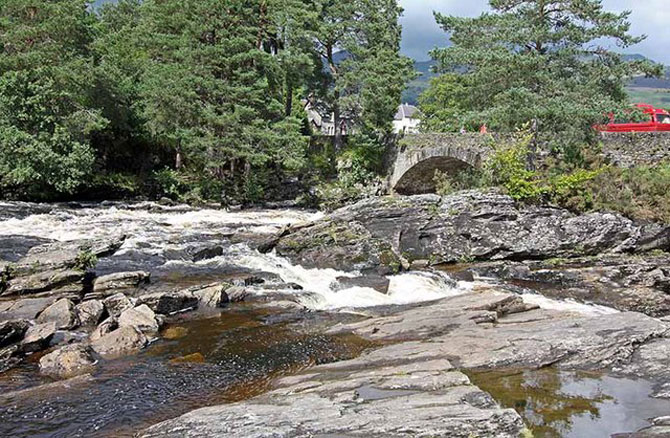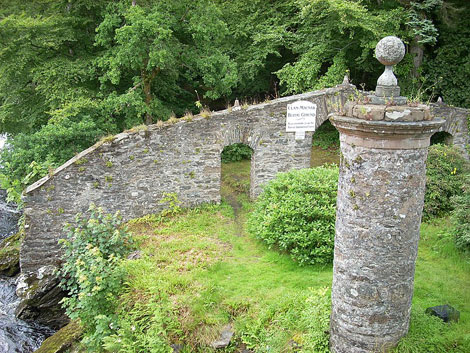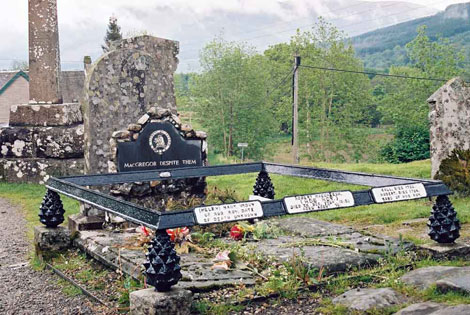
Killin is a popular visitor destination situated on the shores of Loch Tay, Perthshire.
As part of the Loch Lomond, The Trossachs, Stirling and Forth Valley Region, it’s one of the prettiest villages in Scotland.
It lies at the heart of Breadalbane (high ground of Scotland) at the western end of Loch Tay.
It is a popular tourist destination, known for its wonderful scenery, traditional Scottish culture, and outdoor activities.
Visitors are particularly drawn to the village to see the Falls of Dochart. The falls are always more dramatic after the rain, which tumbles under the stone River Dochart Bridge, part of the main road into the village.
There are a variety of walking and hiking trails in the surrounding countryside, and the village is also a good base for fishing, canoeing, and other water sports.
The proximity to Loch Tay means water sports are popular, canoeing and kayaking in particular. If you haven’t brought your own, they can be hired from the Killin Outdoor Centre and Mountain Shop.
In season, trout and salmon fishing bring visitors to the village and boats can be hired locally.
Killin also lies within the boundaries of the Loch Lomond and The Trossachs National Park.
The Rob Roy Way one of Scotland’s Long Distance walks, which runs within the National Park, includes a section that runs from Killin to Ardtalnaig. The Walk Highlands website has all the details.
Finlarig Castle
For history lovers, there are a number of sites to explore. The ruins of Finlarig Castle, built by Duncan of Glenorchy to a z design and dating to the early 17th century lies around half a mile north of Killin between the River Lochay and Loch Tay.
A little to the east of the castle are the remnants of a mausoleum built by Campbell of Breadalbane at the beginning of the 19th century. The two nearby graves mark the final resting place of the Marquis and Marchioness of Breadalbane.
For history enthusiasts, there are a few sites, close to Killin. with standing stones and stone circles:
- Fingal’s Stone: This standing stone, located near Killin, is named after Fingal, a legendary hero in Scottish folklore. It is said to mark the grave of Fingal’s son.
- Killin Stone Circle (Kinnell Stone Circle): believed to date back to the Bronze Age.
- Acharn Falls Stone Circle: Located near the village of Acharn on the south side of Loch Tay, this is another example of a Bronze Age stone circle.
Clan MacNab
The village is inextricably linked with the Clan MacNab, who may have been descended from a son of King Kenneth I.
The destruction, by Cromwell’s soldiers in 1654, of Eilan Ran Castle at the head of Loch Tay forced the clan chief to move their seat to Kinnell House, also the site of a Middle Bronze Age stone circle.

The MacNab burial ground is on Inchbuie, a small island, close to the falls, on the River Dochart. The Royal Commission on the Ancient and Historic Monuments of Scotland notes “among the grave slabs and effigies is a medieval slab bearing a kilted figure.”
Accommodation in Killin
If you are staying for a few days, Killin has a decent range of hotels, guest houses and bed and breakfasts. There is a camping and caravan site at Glen Dochart Holiday Park situated between Killin and Crianlarich.
The village also boasts a range of small independent shops, including an outdoor centre popular with locals and visitors.
There are plenty of places to eat in Killin. With its variety of hotels restaurants, pubs and takeaways. There is something to suit every taste and budget
Killin: the surrounding area
Although the village of Killin is a wonderful place to relax and enjoy Killin is an ideal place to use as a base to explore the surrounding area and further afield too.
For golfers, a nine-hole course lies just outside the village on Aberfeldy Road. Visitors are welcome and equipment can be hired.
Aberfeldy Distillery
The small town of Aberfeldy, about 25 miles from Killin is the home of Dewars Aberfeldy Whisky Distillery.
The distillery welcomes visitors and offers several whisky tours and experiences.
- Visit the official Dewar’s website for more information.

Ben Lawers National Nature Reserve
Less than ten miles from Killin is the Ben Lawers National Nature Reserve operated by the National Trust for Scotland. The reserve is well-known for its diverse Arctic-Alpine flora.
It’s a great place for walkers and climbers, who on a good day can look over Ben Lomond and Glencoe to the west and the Cairngorms to the north. In the summer there are a range of guided walks and other events.
The Edramucky Trail takes walkers through a scenic mix of woodlands and open moorland. The starting point is the Ben Lawers car park allowing easy access to the mountain which rises to 1,214m (3,984ft).
Visit the National Nature Reserve’s official website for more information.
Kenmore
Also on the shores of Loch Tay, the small village of Kenmore is home to the Scottish Crannog Centre with its unique representation of an early Iron Age loch dwelling.
It’s a fascinating place and well worth the visit. It’s very much a hands-on experience, the kids will be fascinated.
The beautiful mountains of Glen Coe lie around 50 miles from Killin.
How to get to Killin from Edinburgh
Killin is an ideal place to use as a base to explore other parts of Scotland. The village is about a 90 minute drive from Glasgow, Edinburgh and Fort William, 75 minutes from Oban and less than an hour to Stirling.
The beautiful mountains of Glen Coe lie around 50 miles from Killin.
The journey from Edinburgh to Killin is probably best made via Stirling, so leave a little extra time to visit Stirling Castle and the visitor centre at the Battle of Bannockburn Experience.
From Stirling take the A84 road through Doune, Callander and Strathyre. From Strathyre you are less than ten miles from Balquidder where you can visit the grave of Rob Roy MacGregor.